Here, at last, is a guide to what Twin Peaks is all abour
par Susan Schindehette, Lissa August à Washington, D.C., John Griffiths, Kristina Johnson et Craig Tomashoff à Los Angeles,
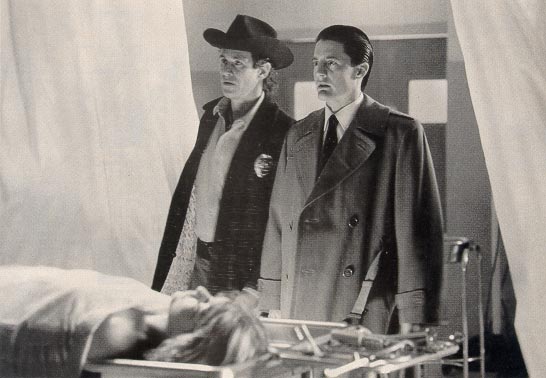
She’s day-ud. Wrapped in plastic. » When hapless fisherman Pete Martell stumbled on the prom queen’s clammy body, blue and Baggied, on the riverbank, he could not have guessed how far the shock waves would roll-not just through the fictional northwest town of Twin Peaks, but through an American TV audience that stretches about as far as the Nielsens can see.
With the most buzzed-about plot line since J.R. got plugged in a 1980 Dallas cliff-hanger, this season’s video phenomenon is ABC’s Twin Peaks, the sleekly sinister story of FBI special agent Dale Cooper’s investigation into the murder of Laura Palmer. Of course, as the denizens of any backwater burg would know by now, Twin Peaks is also a kind of Our Town through the Looking Glass, where doughnuts, deer heads and even percolated fish portend the evil lurking beneath a smalltown veneer. It’s brimming with off-the wall characters-a dwarf who shows up in a dream, the mysterious Log Lady (see page 89)-who may or may not offer clues to the homicide. And it’s crammed with dialogue that’s sometimes witty, sometimes opaque, sometimes both. So not only do aficionados want to solve the murder (a solution may pop up in the season finale Wed., May 23, at 10 P.M.); they also have their hands full finding out what it all means.
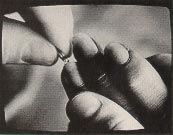
At the morgue (top), Truman (michael Ontkean, left) and Cooper (Kyle MacLachlan) find a clue – or do they? – in Laura’s nails.
Even if viewers require a freeze-frame VCR (or our Who’s Who, pages 84-85) to make sense of a convoluted plot that lost its bearings long ago, Twin Peaks’s probing drill bit has hit a resounding nerve. « I was totally charmed by the idea of this small town being riddled by nasty secrets, » says Patricia Aufderheide, an assistant professor of communications at Washington, D.C.’s American University, « because that was my experience growing up in a small Minnesota town. »
Others see the series as a savior of TV « The cloying, horrid normalcy of the Cosby generation has finally fed up those of us who never bought it anyway, » says L.A. disc jockey Boyd Britten. « Hopefully we’re going to have TV for people who like things just a little weirder. »
For the time being, at least, it would seem so. The show’s stylish surrealism is centrifuged in the brain of producer-director-writer David Lynch, whose rococo past credits -Eraserhead, The Elephant Man, Dune and Blue Velvet-may, as he insists, make Peaks look normal by comparison. « I still don’t see what the great difference is, » Lynch has said. « To me, it’s a regular television show. »
And the Rockies are regular hills. « It’s like Peyton Place gone nuts, » says director John (Cry-Baby) Waters, who knows a thing or two about weirdness himself. « It’s my favorite thing on TV. » Kooky comedian Julie Brown puts it more simply: « Any show that ends an episode with a vibrating dwarf is my kind of TV. »
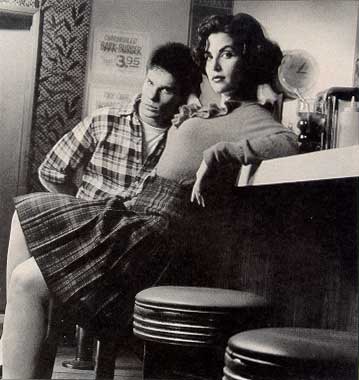
Sultry Audrey Horne (Sherilyn Fenn) hangs out with James Hurley (James Marshall) but has eyes only for agent Cooper.
In addition to its confounding plot line, the series plays like a pop culture Hall of Fame, resonating against everything from The Fugitive’s one-armed man to Tibetan asceticism to the namesake 1944 thriller that starred Gene Tierney. « I call the show a cultural compost heap, » says Peaks co-creator Mark Frost, a onetime writer for Hill Street Blues. « There are symbols and characters and expressions from all the shows we saw growing up that echo and ping down the hallways of Twin Peaks. » Even local sheriff Harry Truman’s name is a double play, conjuring up not just the former U.S. President, but also the 84year-old man who met his end in the 1980 eruption of Mount St. Helens.
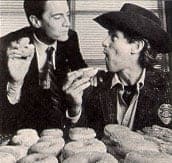
On a break from pie, ever-ravenous Cooper and Truman indulge in « a deputy’s dream, » the morning doughnut lineup.
In the month since the show first landed on the airwaves, an estimated 30 million viewers have gotten ensnared in Twin Peaks’s sub-rosa complexity. « I thought the dream sequence was the strangest six minutes of TV America ever saw, » says a Philadelphia deejay who goes by the single name of Harvey. « The big debate the callers had was how the dialogue was done. » (In fact, the segments, which featured the dwarf and a Laura Palmer look-alike speaking eerily distorted lines, were accomplished by having actors actually speaking their lines in reverse during taping.)
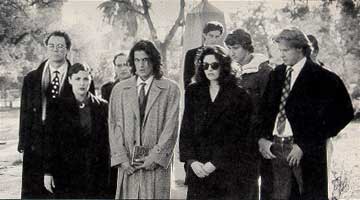
Among the mourners at Laura’s funeral are (front, l.-r.) local businessman Benjamin Horne (Richard Beymer), Audrey Horne (Sherilyn Fenn), Johnny Horne (Robert Bauer), cousin Madeleine Ferguson (Sheryl Lee) and Mike Nelson (Gary Hershberger).
On school campuses, kids who ought to be studying for finals are instead camped out at Thursday-night viewing parties. In Denver, 200 fans turn out for a viewing party at the local Deadbeat Lounge, and spend the post-show wee hours drinking « Blue Velvets » and watching Eraserhead on a 30-foot video screen. Even the hallowed halls of the U.S. Capitol have become Peaks territory. During one recent pre-press conference issues briefing, says senatorial assistant press secretary Deborah Brunton, « the subject of Twin Peaks came up. We started analyzing the dream sequence while the press corps all waited. » Still, the Most Loyal Fan title may belong to 23-year-old Mila Roschwalb, who, waking up groggily after a tonsillectomy one Thursday in a Maryland hospital, turned to her mother and croaked, « Did I miss Twin Peaks? »
Not even Lynch’s inner circle is immune to the mania. At L.A.’s Home Plate Bar, as many as 80 of the show’s cast, crew and friends have gathered for Thursday-night viewings. Two weeks ago, there was nothing but silence as actors Michael Horse (Deputy « Hawk ») and Kimmy Robertson (Lucy Moran) watched the plot unfold. Then, as Agent Cooper makes an inquiry about Twin Peaks real estate, Charlotte Stewart (Mrs. Briggs) broke the tension. « Oooh! » she squealed, clapping her hands together, « Agent Cooper’s moving to Twin Peaks! »
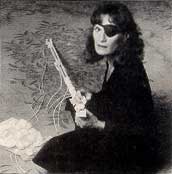
Using greased cotton balls, nutso Nadine Hurley (Wendy Robie) realizes her dream: the first silent drapery runner.
Just tracking Peaks’s slippery story line is enough to confound even fanatic viewers; the plot contains more herring than the North Atlantic. Some diehards have successfully uncovered a 113-minute European version that incorporated an 18-minute dream sequence and, purportedly, the true identity of Laura’s killer. « I sent out a systemwide computer message here that I had a synopsis and that I knew who killed Laura Palmer, » says Washington Post film critic Hal Hinson. « I copied it and put it out for everyone. They were all snapped up immediately. » Too bad. According to Mark Frost, the foreign version was whipped up to meet a contractual obligation and has no bearing on what U.S. viewers will eventually see.
Others may have to make do with Agent Dale Cooper’s Tibet-inspired intuitive techniques-dreams or throwing rocks at targets that might pinpoint the murderer -which, according to one expert, may actually not be as loony as they appear. « It sounds weird, but there really were people who thought about cases in their sleep, » says former special agent Herb Clough, a 30-year FBI veteran. « The facts in your subconscious really would all fit together. »
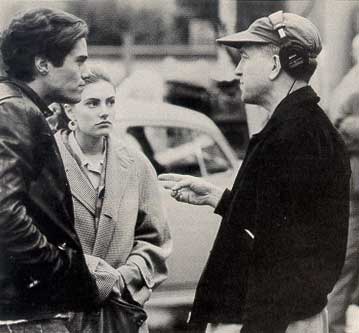
On the Twin Peaks set, Lynch, at right, directs Dana Ashbrook (as Bobby Briggs) and Mädchen Amick (Shelly Johnson).
While viewers try to plumb Peaks’s depths, studio executives are using Cooper-style methods to decipher the Nielsens. So far, the huge 33 share for the pilot has fallen off to 18, but ABC Entertainment president Robert A. Iger professes not to worry. « Even if it loses a little steam, » he says, « it’s still a wave. » That may portend a fall renewal.
In the meantime, the deepening plot leaves room for a lot of creative conjecture from Peakies. Cast members’ lips are sealed, but Frost promises that, whether or not the series is renewed, viewers will « feel satisfied » about its resolution. In the end, the best prognostication comes from actor Dennis Hopper, who played a nitrous oxide-sniffing psychopath in Lynch’s Blue Velvet. The real responsibility for bumping off Laura Palmer, says Hopper, falls on one man: David Lynch. It seems that he, like Twin Peaks, is a real killer.
After her death, two vital (maybe) pieces of evidence, a diary and a video camera, were found in Laura’s bedroom.
People, 14 Mai 1990


Sorry, the comment form is closed at this time.